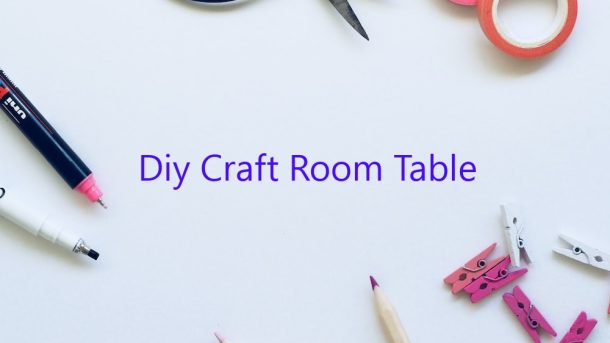A craft room is a room in your home where you can go to be creative and make things. It can be a fun, relaxing place to spend some time. If you don’t have a craft room, you can easily create one by using a spare bedroom, corner of a room, or even in your attic or basement.
One of the most important pieces of furniture in a craft room is a crafting table. This is a table where you can spread out your materials and projects and work on them. If you’re lucky, you might have a large enough table in your craft room that you can use it as your desk too. But if not, no problem – you can easily create a craft room table out of a regular desk or kitchen table.
Here are some instructions on how to make a DIY craft room table:
1. Choose a table that is the right size for your space.
2. If the table is too large, you can cut it down to size with a saw.
3. If the table is too small, you can add a piece of plywood or a sheet of MDF to the top to make it larger.
4. Cut a hole in the middle of the table top for your sewing machine or other machine to fit through.
5. If the table doesn’t have any drawers, you can add some by attaching some drawer slides to the bottom of the table.
6. Paint or stain the table to match the rest of your craft room furniture.
Once you have your craft room table finished, you can start filling it up with all of your crafting supplies. Here are some ideas:
– Sewing supplies: fabric, thread, needles, pins, scissors, measuring tape, iron
– Knitting supplies: yarn, knitting needles, crochet hooks, measuring tape, scissors
– Crafting supplies: paper, scissors, glue, glitter, markers, paint
– Art supplies: canvas, paints, brushes, chalk, charcoal
Contents
How do you make a craft table?
A craft table is a great addition to any crafting enthusiast’s home. Not only does it provide a large surface area on which to work, but it also offers storage for all of your crafting supplies. If you’re in the market for a craft table, or are wondering how to make your own, here are a few tips.
The first step is to decide what size you want your table to be. This will depend on the space you have available and the type of crafting you plan to do. A good rule of thumb is to choose a table that is at least as wide as your widest project.
Once you’ve determined the size, it’s time to build the frame. You can use any type of lumber you like, but a good option is pine, which is inexpensive and easy to work with. Cut the lumber to the desired dimensions, then assemble the frame using wood glue and nails or screws.
If you want to add a top, now is the time to do it. You can use a piece of plywood or any other type of sturdy material. If you’re using plywood, be sure to sand and paint or seal it before you add it to the table.
The last step is to add the legs. You can buy legs or make your own from lumber. If you choose to make your own, simply cut the lumber to the desired length, then attach it to the bottom of the table frame with screws or nails.
And that’s it! Your craft table is now ready to use. be sure to add some storage solutions, such as baskets or crates, to keep your supplies organized.
What height should a craft table be?
What height should a craft table be? The height of a craft table should be adjustable to accommodate the person using it.
How do you turn a room into a craft room?
There are many ways that you can turn a room into a craft room. The most important thing is to make sure that the room is comfortable and organized so that you can be productive while crafting.
One way to make a room more craft-friendly is to add a desk or table to the space. This will give you a place to work, and you can also use it to store your crafting supplies. If you don’t have a lot of space in your craft room, you can use a folding table or a table that can be moved out of the way when you’re not using it.
You may also want to add some shelves to the room. This can be a great way to store your supplies and to keep your work area organized. If you don’t have any shelves, you can use a bookshelf or even a closet to store your supplies.
Another important thing to consider when turning a room into a craft room is the lighting. You’ll want to make sure that the room is well lit so that you can see what you’re doing. You may want to add a lamp or some other type of lighting to the room.
Finally, you’ll want to make sure that the room is comfortable. You may want to add a chair or a couch to the room so that you can take a break from crafting. You may also want to add some decorations to the room to make it more comfortable and inviting.
How do you maximize space in a craft room?
If you’re like many crafters, you may find that your craft room is too small. Even if you have a lot of space, it can be difficult to figure out how to best use it. Here are some tips for maximizing the space in your craft room.
1. Use every inch of wall space. Hang shelves and cabinets to store your supplies.
2. Use storage bins and boxes to organize your supplies.
3. Use a rolling storage cart to store your supplies.
4. Use a pegboard to hang your tools.
5. Use a craft desk to provide a work surface.
6. Use a storage cabinet to store your fabric.
7. Use a quilt rack to store your fabric.
8. Use a tote rack to store your supplies.
9. Use a fabric storage bin to store your supplies.
10. Use a trash can to store your supplies.
How do you make a wooden craft table?
When it comes to crafting, you need a surface to work on. This is especially true if you do a lot of sewing, quilting, or other projects that require a lot of space. A crafting table can provide that extra space, and it can be a beautiful addition to your craft room.
You can make a wooden crafting table yourself, and it’s not as difficult as you might think. In this article, we’ll show you how to make a simple wooden crafting table.
The first step is to gather the materials you’ll need. For this project, you’ll need a piece of plywood that’s at least 48” x 30”, a piece of 1” x 2” lumber that’s at least 60” long, a piece of 3/4” x 2” lumber that’s at least 30” long, a piece of 3/4” x 2” lumber that’s at least 60” long, a piece of 1 1/2” x 1 1/2” lumber that’s at least 12” long, and a piece of 3/4” dowel that’s at least 12” long.
You’ll also need a drill, a jigsaw, a circular saw, a measuring tape, a level, a hammer, a chisel, and a sawbuck.
The first step is to cut the plywood to size. Cut the plywood so that it’s 48” wide and 30” long.
Next, cut the 1” x 2” lumber into four pieces that are each 60” long.
Then, cut the 3/4” x 2” lumber into two pieces that are each 30” long.
Next, cut the 3/4” x 2” lumber into four pieces that are each 60” long.
Last, cut the 1 1/2” x 1 1/2” lumber into two pieces that are each 12” long.
Now, it’s time to assemble the table. Drill two 1/2” holes in each of the four 3/4” x 2” lumber pieces that are 60” long. These will be the legs of the table.
Next, use a jigsaw to cut a half-circle out of the center of each of the four 3/4” x 2” lumber pieces that are 30” long. These will be the table tops.
Now, it’s time to put the table together. Starting with the legs, drill 1/2” holes in each end of the two legs that are 60” long.
Next, use a hammer and a chisel to create a groove in each end of the two table tops that are 30” long. The groove should be about 1/4” wide and 1/4” deep.
Insert the dowel into the groove in one of the table tops.
Then, insert the other table top over the dowel, and use a hammer to tap the table top into place.
The last step is to attach the table legs to the table. Drill 1/2” holes in the ends of the two table legs that are 60” long.
Then, use a level to make sure the table is level. If it’s not, use a hammer to adjust the
What can I use on top of a craft table?
When it comes to crafting, a craft table is a must-have. This is where you’ll put all of your supplies and materials, and it’s a great place to work on your projects. If you’re looking for a way to make your craft table even better, here are a few things you can use on top of it.
One great option is a crafting mat. This is a piece of material that’s designed to protect your table from messes and spills. It also makes it easier to clean up any crafting messes, so it’s a great option if you’re not very careful with your supplies.
Another option is a self-healing cutting mat. This is a mat that’s designed for use with a craft knife, and it helps to protect your table from cuts and scratches. If you do a lot of crafting with a craft knife, a self-healing cutting mat is a great option to consider.
Finally, you can also use a glass crafting surface. This is a piece of glass that’s designed for use with crafting materials, and it’s a great way to protect your table from messes. It’s also a great option for projects that involve a lot of messes, such as dyeing or painting.
What is the best size for a cutting table?
There is no definitive answer to the question of what is the best size for a cutting table, as it depends on your specific needs and preferences. However, there are a few things to keep in mind when choosing a cutting table size.
The most important thing to consider is the type of work you will be doing on the table. If you will be doing a lot of large-scale projects, you will need a larger table. If you will mostly be working on smaller projects, a smaller table may be more appropriate.
Another thing to consider is the amount of space you have available. If you don’t have a lot of space to spare, a smaller table may be a better option.
Finally, your personal preferences should be taken into account. Some people prefer a smaller table for easier maneuverability, while others prefer a larger table for more space to work on projects.
Ultimately, the best size for a cutting table is a personal decision that should be based on your specific needs and preferences.



